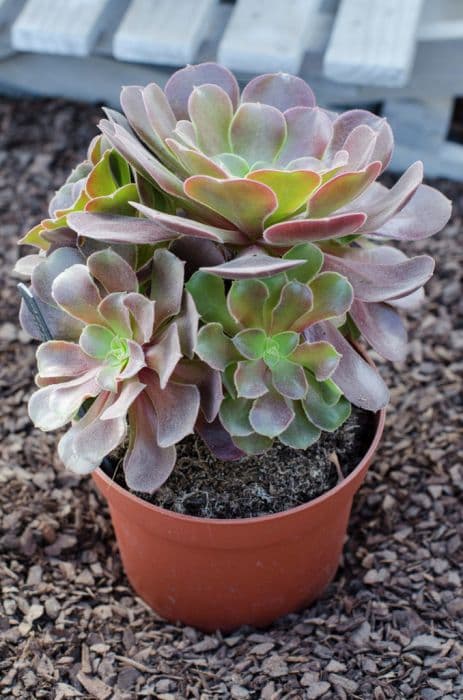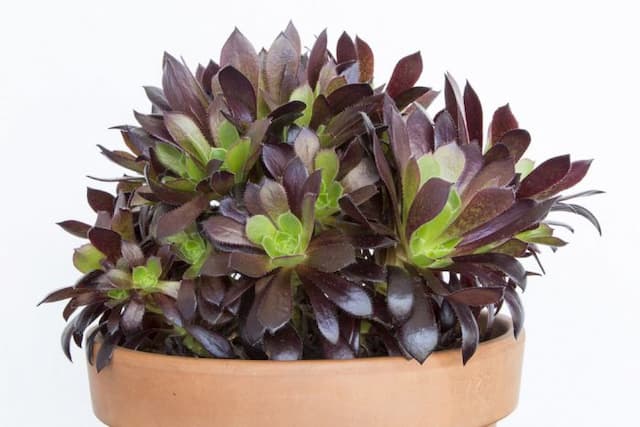Black Rose Aeonium arboreum 'Atropurpureum'

ABOUT
Aeonium arboreum 'Atropurpureum', commonly known as Black Rose or Black Tree Aeonium, is a striking succulent with a distinctive appearance. This attractive plant forms rosettes of fleshy, spoon-shaped leaves that have a deep purple, almost black coloring. The glossy leaves can create a dramatic visual contrast when placed among plants with lighter or greener foliage. The Black Rose's rosettes are composed of leaves that radiate from a central point, creating a symmetrical pattern reminiscent of a flower, and the leaves can sometimes appear to have a reddish hue when hit by sunlight. During its blooming period, it may produce pyramidal clusters of small, star-shaped flowers that are typically a contrasting yellow in color, adding to its decorative appeal. This plant tends to have multiple branches, giving it a shrub-like look with each branch terminating in a rosette. Although it is a succulent and stores water in its thick leaves, it does not have the typical swollen appearance of some other succulents. Instead, its allure comes from the elegance of its dark foliage and its overall architectural form. As a popular choice for rockeries, succulent gardens, or as a potted specimen, Black Rose brings a touch of exotic intrigue and a modern aesthetic to any setting where it is grown, offering a bold visual statement without the need for considerable upkeep or complex care routines.
About this plant
 Names
NamesSynonyms
Black Rose, Black Beauty, Black Tree Aeonium, Dark Purple Aeonium, Black Aeonium, Purple Rose, Gothic Aeonium.
Common names
Sempervivum arboreum, Aeonium manriqueorum, Aeonium arboreum var. atropurpureum.
 Toxicity
ToxicityTo humans
The Black Rose succulent, a variety with dark purple leaves, is generally not considered toxic to humans. Ingesting any part of this plant typically does not lead to poisoning or adverse symptoms.
To pets
The Black Rose succulent is not known to be toxic to pets. Therefore, if a pet ingests parts of this plant, it is unlikely to experience poisoning or related symptoms due to its non-toxic nature.
 Characteristics
CharacteristicsLife cycle
Perennials
Foliage type
Evergreen
Color of leaves
Purple
Flower color
Yellow
Height
3 feet (0.91 meters)
Spread
2 feet (0.61 meters)
Plant type
Succulent
Hardiness zones
9
Native area
Canary Islands
Benefits
 General Benefits
General Benefits- Decorative Appeal: The Aeonium arboreum 'Atropurpureum', also known as Black Rose or Black Tree Aeonium, has deep purple, almost black foliage that adds a dramatic touch to gardens and containers.
- Drought Tolerance: Black Rose is a succulent, meaning it requires minimal water once established, making it ideal for xeriscaping and drought-prone regions.
- Easy Propagation: Propagating Black Rose is straightforward; cuttings can be taken and easily rooted to create new plants.
- Low Maintenance: As a succulent plant, it requires very little upkeep in terms of fertilization, pruning, and watering, making it ideal for those who prefer low-maintenance gardening.
- Suitable for Containers: Black Rose is well-suited for pot culture, which allows for growth in small spaces, on patios, balconies, and indoors.
- Attracts Pollinators: When in bloom, typically in late winter to spring, the yellow, star-shaped flowers can attract bees and other pollinators to the garden.
- Year-Round Interest: The evergreen nature of Black Rose ensures that it remains an attractive feature in the garden throughout the year.
- Coastal Garden Suitable: Black Rose is tolerant of sea spray and saline soils, making it a good choice for coastal gardens.
- Versatile Landscaping Plant: This plant can be used in rock gardens, as a groundcover, in alpine gardens, and in other landscaping designs that benefit from its unique form and color.
 Medical Properties
Medical PropertiesThis plant is not used for medical purposes
 Air-purifying Qualities
Air-purifying QualitiesThis plant is not specifically known for air purifying qualities.
 Other Uses
Other Uses- Photography and Art Inspiration: Gardeners and artists often use the sculptural forms of Aeonium arboreum 'Atropurpureum', also known as Black Rose, as a subject for photographic compositions and paintings due to its deep purple rosettes.
- Educational Tool: Black Rose can be used in educational settings to teach about succulent care, propagation, and the adaptations that enable them to survive in arid environments.
- Insect Habitat: When planted outdoors, the Black Rose can provide a microhabitat for small insects, which in turn can benefit the local ecosystem by promoting biodiversity.
- Theme Gardens: The distinctive color and form of Black Rose makes it suitable for themed garden displays, such as gothic or "black" gardens that feature plants with dark foliage.
- Landscape Contrast: Black Rose can be planted among green succulents or bright flowers to create a visual contrast in gardens and landscapes, enhancing aesthetic appeal.
- Seasonal Decor: The Black Rose's color fits well with Halloween decor, and the plant can be used in seasonal displays or as centerpieces during the fall season.
- Mindfulness and Focus Practices: The steady growth and maintenance of Black Rose can aid in mindfulness practices, requiring observation and care that can sharpen focus.
- Drought Tolerance Education: This plant is an example used in workshops and courses focusing on drought-tolerant landscaping and water conservation methods.
- Crafting and Decoration: Dried rosettes of Black Rose can be incorporated into wreaths, terrariums, or other craft projects for a unique, natural embellishment.
- Green Roofing: Due to its low water requirements and shallow root system, the Black Rose can be used on green roofs to help insulate buildings while providing an attractive plant cover.
Interesting Facts
 Feng Shui
Feng ShuiThe Black Rose is not used in Feng Shui practice.
 Zodiac Sign Compitability
Zodiac Sign CompitabilityThe Black Rose is not used in astrology practice.
 Plant Symbolism
Plant Symbolism- Endurance and Survival: The Aeonium arboreum 'Atropurpureum', commonly known as Black Rose, is a succulent that can withstand harsh conditions, making it a symbol of endurance and the ability to survive and thrive in challenging environments.
- Strength and Protection: The fleshy and robust nature of the Black Rose, combined with its rosette shape that resembles a fortress, may symbolize strength and the ability to protect oneself and others.
- Timeless Beauty: With its dark burgundy, almost black leaves that retain their color and form, the Black Rose can represent enduring and timeless beauty, suggesting a grace that doesn't fade with age.
- Wealth and Prosperity: Succulents, in general, are often associated with wealth and prosperity, and the unique aesthetics of the Black Rose may also symbolize opulence and the richness of life.
- Mystery and Magic: The unusual color of this plant gives it an air of mystery and magic, making the Black Rose a symbol of the mystical and the enigmatic elements of nature.
- Adaptability: As a plant that can thrive in poor soil and requires minimal water, the Black Rose symbolizes adaptability and the ability to find a way to grow and flourish in diverse conditions.
 Water
WaterThe Black Rose succulent should be watered thoroughly, allowing the water to drain freely from the bottom of the pot, when the top inch of the soil feels dry to the touch. On average, this could mean watering approximately every 7 to 10 days during the active growing season in spring and summer. During the dormant season in fall and winter, reduce watering to every 2-3 weeks, depending on the humidity and temperature in your home. Make sure not to overwater as this can lead to root rot; a common sign of overwatering is leaves that are yellowing and falling off. It is better to underwater than overwater, as the succulent can tolerate drought. When watering, use room temperature water, and for a potted plant, using about 8-16 ounces at a time should suffice depending on the pot size.
 Light
LightBlack Rose succulents thrive in bright, indirect sunlight and can also tolerate full sun, especially in cooler climates. The ideal spot for this plant is in an east or west-facing window where it can get a few hours of direct light in the morning or late afternoon, but protection from the harsh afternoon sun. If placed outside, partial shade is recommended to prevent sunburn on the leaves, especially during the hottest part of the day.
 Temperature
TemperatureBlack Rose succulents prefer temperatures between 65°F and 75°F, but can survive in temperatures as low as 40°F and as high as 100°F for short periods. It's important to protect the plant from frost, which can be damaging, and to ensure the temperature does not drop below 40°F, especially overnight. The ideal temperature range will promote healthy growth and maintain the vibrant colors of the succulent.
 Pruning
PruningPruning Black Rose succulents is primarily done to remove any dead or damaged leaves to maintain the plant's appearance and health. Light pruning can be done as needed throughout the year, but major pruning is best performed in the early spring before the new growth begins. This is also the time to cut back any leggy stems to encourage fuller, more compact growth. Be sure to use clean, sharp scissors or pruning shears to make precise cuts.
 Cleaning
CleaningAs needed
 Soil
SoilThe Black Rose, or Aeonium arboreum 'Atropurpureum', thrives in a well-draining soil mix composed of two parts potting soil to one part perlite or coarse sand. Adding some organic matter can also be beneficial. This succulent prefers slightly acidic to neutral pH levels, around 6.0 to 7.5.
 Repotting
RepottingBlack Rose succulents should be repotted approximately every two to three years or when they outgrow their container. Ensure to use a well-draining soil mix and a slightly larger pot to accommodate growth.
 Humidity & Misting
Humidity & MistingBlack Rose succulents prefer a dry atmosphere and will thrive in average room humidity levels. Try to avoid excessively humid environments, as high humidity can lead to rot and fungal diseases in these plants.
 Suitable locations
Suitable locationsIndoor
Place Black Rose in bright, indirect light indoors for best growth.
Outdoor
Grow Black Rose in full to partial sun outdoors with well-draining soil.
Hardiness zone
9-11 USDA
 Life cycle
Life cycleThe life of Aeonium arboreum 'Atropurpureum', commonly known as Purple Aeonium, begins with a seed stage, where the tiny seeds germinate when conditions are cool and moist. The seedlings develop into rosette-forming juveniles, with leaves that initially may not show the characteristic deep purple hue. As the plant matures, it enters a vegetative growth phase where the rosettes become larger, and the dark purple, almost black pigmentation becomes pronounced, often intensifying with more sunlight exposure. The Purple Aeonium may then go through a dormancy period during hot and dry conditions, where growth slows drastically. After several years, the mature plant produces pyramidal inflorescences with star-shaped yellow flowers, usually in the spring or early summer, marking its reproductive phase. Following flowering, the monocarpic stems of the Purple Aeonium die back, but because the plant produces offsets, new rosettes continue to grow, thereby continuing the life cycle.
 Propogation
PropogationPropogation time
Spring-Early Summer
Propogation: The most popular method of propagation for the Aeonium arboreum 'Atropurpureum', commonly known as Black Rose aeonium, is through stem cuttings. The best time to propagate is during the plant's active growing season, which is generally in the spring or early summer. To propagate, a healthy stem is selected and cleanly cut with a sharp, sterilized knife or scissors, making the cutting about 3 to 4 inches (approx. 7.6 to 10.2 cm) long. The cut end should be allowed to dry and callous over for a few days to prevent rot when planted. Once the end is calloused, the cutting can be planted in well-draining soil, keeping it lightly moist until roots are established. It may take several weeks for new roots to form. This simple process helps in creating new plants that are genetically identical to the parent.









